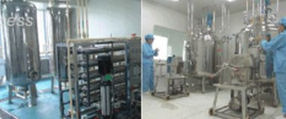Indiase ginseng-Ashwagandha - Extractpowders
Processing
The Ashwagandha herb (Withania somnifera) is not a member from the Araliaceae family and is therefore not a real ginseng. Because some adaptogene actions are comparable with those from real ginseng, it is also called Indian Ginseng.Ashwagandha is considered as one of the most important rejuvenating herbs in Indian medicin. It's a herb that works on a non-specific basis to promote overall health and longevity.
After the dry Ashwagandha roots have been analyzed and selected, they go into a carefully controlled extraction process with the desired concentration of withanolides as a result.
 |
A highly controlled processing method ensures that the dry Ashwagandha roots are processed into extract powders according approved standard processes. |
Composition of root powders
Ashwagandha extract powders are only made from the dried roots of the plant.Apart from some exceptions, almost all basic Ashwagandha extract powders are made without carriers or additives. At a customer's request a desired additive can still be added.
Packaging
For amounts less than 25 kg, Ashwagandha extract powders are packed per 1 kg in airtight aluminum bags with PE-inner layer. Bags with 5 kg are also available.Larger bulk quantities are packed in standard plastic bags in cardboard boxes or barrels.
Properties
Regular Ashwagandha extract powders hardly dissolve in water. With some adjustments in the production process it is possible to make extract powders that dissolve very well in water.The color of the powder is yellow-brownish.
The regular Ashwagandha extract powders have a characteristic bitter taste. As the level of withanolides rises, the products bitter taste intensifies.
For some purposes the bitter taste of Ashwagandha is not desired. There are ways to decrease the intensity of the bitter taste.
A possible practical disadvantage from Ashwagandha extract powders is that they are quite hygroscopic: they easy attract moisture from the air.
When not preserved the right way the powder is at risk of clotting together. Keeping it dry in closed packaging is therefore important.
Additives
To reduce the costs of the extract powder, adding filler is an option. The cheapest filler is ground rice flour.For technical and sometimes taste sensory reasons also other possible additives like: dicalcium phosphate, malto dextrin, silicon dioxide, magnesium stearate or glucose powder are used. Of course other additives, carriers or fillers are possible too.
Another benefit of adding filler to the extract powder is that it can drastically decrease the hygroscopic nature of the product.
Dosage
In-vitro-tests have shown that the absorption of withanolides from extracts is double the absorption of dried roots or root powders. Counted in milligrams, this means that in order to get the same results a double dose of ground root powders is needed in comparison to extract powders.For optimal therapeutic results of Ashwagandha extract powders it is advised to take 600-1000 mg of an extract powder containing 1,5% withanolides daily. As a food supplement often a daily dosage of 300-500 mg of this extract powder is advised.
Practical experiences have demonstrated that activity and effects of Ashwagandha do not decline proportionally as a daily dose is lowered.
There is not really a dangerous (damaging) maximum daily dose set, but 50-100 mg of a concentrated extract powder is considered as a minimal dose. If you take less than this dosage a day it will most likely not contribute anything.
When mixed with other medicinal herbs, a lower dose of Ashwagandha might be sufficient.
 |
 |
| previous | next |
